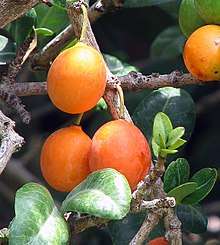imbe
English

Etymology
?
Noun
imbe (plural imbes)
- The originally African tree Garcinia livingstonei.
- 1928, Otis Warren Barrett, The Tropical Crops
- The danealan, G. subelliptica, is a 30- to 40-foot tree of the eastern coast of Luzon. [...] The imbe has fruited in southern Florida, but probably it is too exacting in its ecological requirements for general cultivation.
- 1944, John MacLaren Waterston, Fruit Culture in Bermuda ...
- Garcinia livingstonei T. Anders., The Imbe, Guttiferae.
- The Imbe has proved quite hardy and successful on the sandy and limestone rock soils of Southern Florida. The fruit obtained [...]
- 1960, William Crawford Kennard, H. F. Winters, Some Fruits and Nuts for the Tropics, page 67:
- Figure 46. - The imbe, Garcinia livingstonei.
- 1993, Tropical Fruit News, page 102:
- Trees grow slowly and this makes them ideal for pot culture; in fact, many people grow imbe as a container tropical fruit for small landscapes. Imbes have separate sexes, so this means you have to have both a male and a female tree ...
- 1993, James J. Darley, Know and Enjoy Tropical Fruit: Tropical Fruit and Nuts: a Cornucopia, P&S Publishing (→ISBN), page 45:
- Purple mangosteen trees have only female flowers and pollen fertilisation is not required. [...] Other Garcinia species, have less to recommend them as a fruit tree; the imbe (G. livingstonei) is small fruited, has a large seed and a little sour flesh.
- 2006, Susanna Lyle, Discovering Fruit & Nuts: A Comprehensive Guide to the Cultivation, Uses and Health Benefits of Over 300 Food-Producing Plants:
- (Guttiferae) Relatives: mangosteen
- A native of eastern Africa, the imbe forms an interestingly-shaped tree and has numerous sweet-sub-acid, tasty bright orange fruits, which can be eaten fresh. It is only cultivated locally ...
- 2008, National Research Council, Policy and Global Affairs, Development, Security, and Cooperation, Lost Crops of Africa: Volume III: Fruits, National Academies Press (→ISBN), page 291:
- Africa's best-known mangosteen relative is the imbe, a tree whose soft and colorful fruits brighten up markets [...]. Imbes come from a shrub or small tree with a dense spreading or conical crown topping a short, often twisted trunk [...]
- 1928, Otis Warren Barrett, The Tropical Crops
Old English
Etymology
From Proto-Germanic *imbijaz, perhaps from Proto-Indo-European *a(m)pi- (“stinging insect, bee”). Cognate with Middle Dutch imme (Dutch imme) and Old High German imbi (German Imme). The proposed Indo-European root would also be the source of Ancient Greek ἐμπίς (empís), Latin apis.
Pronunciation
- IPA(key): /ˈimbe/
Old Irish
Pronunciation
- IPA(key): /ˈimʲbʲe/
Mutation
| Old Irish mutation | ||
|---|---|---|
| Radical | Lenition | Nasalization |
| imbe | unchanged | n-imbe |
| Note: Some of these forms may be hypothetical. Not every possible mutated form of every word actually occurs. | ||
This article is issued from
Wiktionary.
The text is licensed under Creative
Commons - Attribution - Sharealike.
Additional terms may apply for the media files.